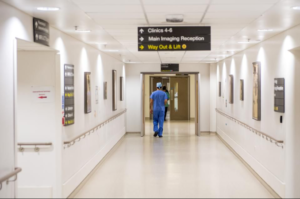Medical staff walks through a corridor inside Royal London Hospital.

Nearly a quarter of a million British patients have been waiting more than six months to receive planned medical treatment from the National Health Service, according to a recent report from the Royal College of Surgeons. More than 36,000 have been in treatment queues for nine months or more. Long waits for care are endemic to government-run, single-payer systems like the NHS. Yet some U.S. lawmakers want to import that model from across the pond. That would be a massive blunder.
Consider how long it takes to get care at the emergency room in Britain. Government data show that hospitals in England only saw 84.2% of patients within four hours in February. That’s well below the country’s goal of treating 95% of patients within four hours – a target the NHS hasn’t hit since 2015. Now, instead of cutting wait times, the NHS is looking to scrap the goal.
Wait times for cancer treatment – where timeliness can be a matter of life and death – are also far too lengthy. According to January NHS England data, almost 25% of cancer patients didn’t start treatment on time despite an urgent referral by their primary care doctor. That’s the worst performance since records began in 2009. And keep in mind that “on time” for the NHS is already 62 days after referral.
Unsurprisingly, British cancer patients fare worse than those in the United States. Only 81% of breast cancer patients in the United Kingdom live at least five years after diagnosis, compared to 89% in the United States. Just 83% of patients in the United Kingdom live five years after a prostate cancer diagnosis, versus 97% here in America.
The NHS also routinely denies patients access to treatment. More than half of NHS Clinical Commissioning Groups, which plan and commission health services within their local regions, are rationing cataract surgery. They call it a procedure of “limited clinical value.”
It’s hard to see how a surgery that can prevent blindness is of limited clinical value. Delaying surgery can cause patients’ vision to worsen – and thus put them at risk of falls or being unable to conduct basic daily activities.
“It’s shocking that access to this life-changing surgery is being unnecessarily restricted,” said Helen Lee, a health policy manager at the Royal National Institute of Blind People.
Many Clinical Commissioning Groups are also rationing hip and knee replacements, glucose monitors for diabetes patients, and hernia surgery by placing the same “limited clinical value” label on them.
Patients face long wait times and rationing of care in part because the NHS can’t attract nearly enough medical professionals to meet demand. At the end of 2018, more than 39,000 nursing spots were unfilled. That’s a vacancy rate of more than 10%. Among medical staff, nearly 9,000 posts were unoccupied.
These shortages could explode in the years to come. In 2018, the Royal College of General Practitioners found that more than 750 practices could close within the next five years, largely because heavy workloads are pushing older doctors to retire early.
The NHS recently announced that, in a desperate attempt to shore up its doctor workforce, it would pay British general practitioners working abroad more than $24,000 in “relocation support” to come back to the country. The Service is also trying to encourage doctors to come out of retirement. Great Britain’s health crisis is the inevitable outcome of a system where government edicts, not supply and demand, determine where scarce resources are allocated.
___________________________
We at ‘Greg Says’ share the concerns of many healthcare professionals that a “Medicare for All” approach to healthcare in the USA poses several risks borne out by the results experienced in Canada and Great Britain.








